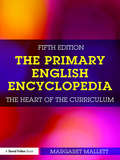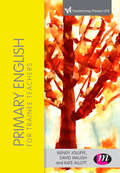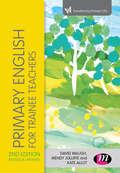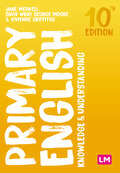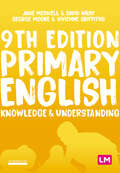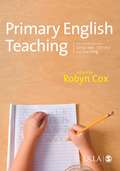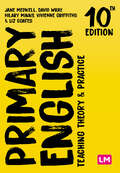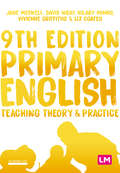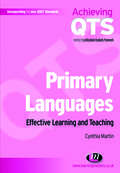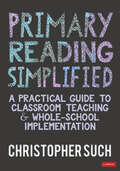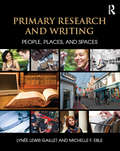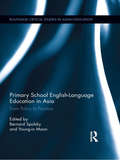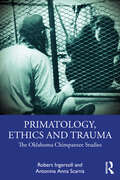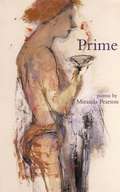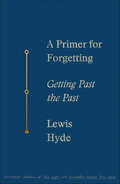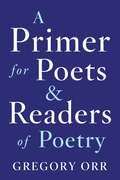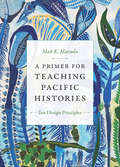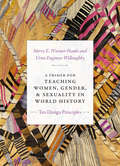- Table View
- List View
The Primary English Encyclopedia: The heart of the curriculum
by Margaret MallettThis newly updated, user friendly Primary English Encyclopedia addresses all aspects of the primary English curriculum and is an invaluable reference for all training and practising teachers. Now in its fifth edition, entries have been revised to take account of new research and thinking. The approach is supportive of the reflective practitioner in meeting National Curriculum requirements in England and developing sound subject knowledge and good classroom practice. While the book is scholarly, the author writes in a conversational style and includes reproductions of covers of recommended children’s books and examples of children’s writing and drawing to add interest. The encyclopedia includes: over 600 entries , many expanded and entirely new for this edition, including entries on apps, blogging and computing; short definitions of key concepts; input on the initial teaching of reading including the teaching of phonics and the other cue-systems; extended entries on major topics such as speaking and listening, reading, writing, drama, poetry, non-fiction, bilingualism and children’s literature; information on new literacies and new kinds of texts for children; discussion of current issues and input on the history of English teaching in the primary years; extended entries on gender and literacy; important references for each topic, advice on further reading and accounts of recent research findings; and a Who’s Who of Primary English and lists of essential texts, updated for this new edition. This encyclopedia will be ideal for student teachers on BA and PGCE courses preparing for work in primary schools and primary school teachers. Anyone concerned with bringing about the informed and imaginative teaching of primary school English will find this book helpful and interesting.
Primary English for Trainee Teachers (Transforming Primary Qts Ser.)
by David Waugh Wendy Jolliffe Kate AllottWith chapter sequencing following the new Curriculum, this book supports you to make use of the opportunities presented in the National Curriculum for effective and engaging Primary English teaching. Covering all areas of the new National Curriculum for primary English and offering insight into effective teaching, it helps you connect what you need to teach, to how it can be taught. It opens up the opportunities in the new curriculum for creative and imaginative teaching and covers all areas of children's literacy from poetry and literature to SPAG. Throughout the text, case studies of teaching are used as a starting point for learning and guidance on practical teaching strategies is included in all chapters. A comprehensive guide to the teaching of primary English that will help you secure your subject knowledge and transform your teaching. Includes the full National Curriculum Programme of Study for English, key stages 1 and 2 as a useful reference for trainee teachers.
Primary English for Trainee Teachers (Transforming Primary QTS Series)
by David Waugh Wendy Jolliffe Kate AllottWhat do trainee teachers need to know about English to teach it effectively in primary schools? How do children learn English and how can students teach it? What does a good primary English lesson look like? Answering these important questions and more, this new edition covers all areas of the new National Curriculum for primary English. By offering insight into effective teaching, it helps students connect what they need to teach to how it can be taught. This book opens up opportunities in the new curriculum for creative and imaginative teaching and covers all areas of children's literacy from poetry and literature to SPAG. Case studies of teaching are used as a starting point for learning, and guidance on practical teaching strategies is included throughout. Now comes with: A new chapter on Multi-modal texts A new chapter on Mastery in English
Primary English Knowledge and Understanding
by George Moore Jane Medwell David Wray Vivienne GriffithsThe essential subject knowledge text for primary English. Secure subject knowledge and understanding is the foundation of confident, creative and effective teaching. The 5th edition of this popular text has a number of new features including a new self assessment section and M level extension boxes to provide further challenge in all chapters. References to the 2007 QTS Standards and the Early Years Foundation Stage are also included. With full coverage of the English curriculum, and updated research summaries reflecting the latest thinking, this text is written to help trainee primary teachers develop and consolidate their knowledge of English.
Primary English: Knowledge and Understanding (Achieving QTS Series)
by David Wray Vivienne Griffiths Jane A Medwell George E MooreThe essential subject knowledge text for primary English. Secure subject knowledge and understanding is the foundation of confident, creative and effective teaching. The trainee teacher′s guide to all the subject knowledge required to teach primary English. Includes practical and reflective tasks to help deepen your understanding and self assessment tests to check your knowledge and identify areas where more study is needed. This 10th edition has been updated throughout and is now linked to the ITT Core Content Framework.
Primary English: Knowledge and Understanding (Achieving QTS Series)
by David Wray Vivienne Griffiths Jane A Medwell George E MooreThe essential subject knowledge text for primary English. Secure subject knowledge and understanding is the foundation of confident, creative and effective teaching. The trainee teacher′s guide to all the subject knowledge required to teach primary English. Includes practical and reflective tasks to help deepen your understanding and self assessment tests to check your knowledge and identify areas where more study is needed. This 10th edition has been updated throughout and is now linked to the ITT Core Content Framework.
Primary English: Knowledge and Understanding (Achieving QTS Series)
by David Wray Vivienne Griffiths Jane A Medwell George E MooreAll the subject knowledge you need to teach primary English. If you are training to be a primary school teacher, you need to understand what you need to know about primary English before you can teach it. Secure subject knowledge and understanding is the foundation of confident, creative and effective teaching. To help you master this, this comprehensive text includes subject knowledge from each part of the primary English curriculum and comes with a wide range of resources so you can test your growing knowledge as you progress through the course. an online English subject knowledge audit with the ability to share results end of chapter self-assessment questions Interactive tasks an English subject knowledge checklist useful weblinks for primary English teaching Recommended further reading This new edition has been updated and includes a new chapter on children′s common misconceptions in English.
Primary English: Knowledge and Understanding (Achieving QTS Series)
by David Wray Vivienne Griffiths Jane A Medwell George E MooreAll the subject knowledge you need to teach primary English. If you are training to be a primary school teacher, you need to understand what you need to know about primary English before you can teach it. Secure subject knowledge and understanding is the foundation of confident, creative and effective teaching. To help you master this, this comprehensive text includes subject knowledge from each part of the primary English curriculum and comes with a wide range of resources so you can test your growing knowledge as you progress through the course. an online English subject knowledge audit with the ability to share results end of chapter self-assessment questions Interactive tasks an English subject knowledge checklist useful weblinks for primary English teaching Recommended further reading This new edition has been updated and includes a new chapter on children′s common misconceptions in English.
Primary English Teaching: An Introduction to Language, Literacy and Learning (Published in association with the UKLA)
by Robyn CoxThis comprehensive introduction to language, literacy and learning in the primary school, explores the theoretical issues that underpin pedagogical practice in the primary English language classroom in a straightforward manner, enabling readers to understand the resulting practice and curriculum offerings in English primary schools today.<P><P> The contributors explore new initiatives in primary language teaching, putting these into their theoretical context, and offer practical ideas, helping students to make the bridge from studying to be a teacher, through to the beginnings of their teaching career. Diversity and aspects of special educational needs are also considered in each section of the book.<P> This book will be essential reading both for undergraduate students of education, as well as for PGCE students.
Primary English: Teaching Theory and Practice (Achieving QTS Series)
by David Wray Hilary Minns Vivienne Griffiths Elizabeth Coates Jane A MedwellThe essential teaching theory and practice text for primary English. This comprehensive and popular text covers the professional knowledge, skills and understanding required to be an effective teacher of primary English. *Practical guidance on the teaching and learning of phonics, the importance of talk in the classroom and the teaching of handwriting and spelling. *Covers the teaching of writing in the early years, KS1 and KS2. *Includes strategies for developing reading comprehension. *Chapters cover inclusion, assessment and organising and resourcing learning in the classroom. This 10th edition has been updated and now includes links to the ITT Core Content Framework.
Primary English: Teaching Theory and Practice (Achieving QTS Series)
by David Wray Hilary Minns Vivienne Griffiths Elizabeth Coates Jane A MedwellThe essential teaching theory and practice text for primary English. This comprehensive and popular text covers the professional knowledge, skills and understanding required to be an effective teacher of primary English. *Practical guidance on the teaching and learning of phonics, the importance of talk in the classroom and the teaching of handwriting and spelling. *Covers the teaching of writing in the early years, KS1 and KS2. *Includes strategies for developing reading comprehension. *Chapters cover inclusion, assessment and organising and resourcing learning in the classroom. This 10th edition has been updated and now includes links to the ITT Core Content Framework.
Primary English: Teaching Theory and Practice (Achieving QTS Series)
by David Wray Hilary Minns Vivienne Griffiths Elizabeth Coates Jane A MedwellAll you need to know about the theory and practice of teaching primary English. If you are training to be a primary school teacher, a knowledge of the primary English curriculum is not enough, you need to know HOW to teach English in primary schools. This is the essential teaching theory and practice text for primary English that takes a focused look at the practical aspects of teaching. It covers the important skills of classroom management, planning, monitoring and assessment and relates these specifically to primary English. Practical guidance, features and resources support you to translate your learning to the classroom and understand the wider context of teaching. The book includes: - Online practical lesson ideas for the classroom - The Primary National Curriculum for English in Key Stages one and two - Tips for planning primary English - A recommended children’s book list - Useful weblinks for primary English teaching This ninth edition has been updated throughout and includes a new chapter on online and ′blended′ learning and teaching for primary English.
Primary English: Teaching Theory and Practice (Achieving QTS Series)
by David Wray Hilary Minns Vivienne Griffiths Elizabeth Coates Jane A MedwellAll you need to know about the theory and practice of teaching primary English. If you are training to be a primary school teacher, a knowledge of the primary English curriculum is not enough, you need to know HOW to teach English in primary schools. This is the essential teaching theory and practice text for primary English that takes a focused look at the practical aspects of teaching. It covers the important skills of classroom management, planning, monitoring and assessment and relates these specifically to primary English. Practical guidance, features and resources support you to translate your learning to the classroom and understand the wider context of teaching. The book includes: - Online practical lesson ideas for the classroom - The Primary National Curriculum for English in Key Stages one and two - Tips for planning primary English - A recommended children’s book list - Useful weblinks for primary English teaching This ninth edition has been updated throughout and includes a new chapter on online and ′blended′ learning and teaching for primary English.
Primary Languages: Effective Learning And Teaching (Achieving QTS Series)
by Cynthia MartinPrimary languages are to be an entitlement for all pupils in KS2 from 2010. There is therefore a need to ensure that trainee primary teachers are equipped with the required skills, knowledge and understanding to contribute to this process. This book supports specialists, and also non-specialist trainees with an interest in MFL, who may need to deliver languages across the curriculum, providing them with a clear understanding of the methodology and helping them to develop linguistic competence and confidence.
Primary Phonics Max and the Fox
by Barbara MakarA systematic, phonics-based early reading program that includes: the most practice for every skill, decodable readers for every skill, and reinforcement materials--help struggling students succeed in the regular classroom
Primary Reading Simplified: A Practical Guide to Classroom Teaching and Whole-School Implementation
by Christopher Such"Such’s passion and knowledge for reading shines through. This is a thoughtful text as well as a practical one." - Schools Week- From the bestselling author of The Art and Science of Teaching Primary Reading, this is your essential guide to teaching reading in primary schools. Filled with classroom-tested, practical guidance, this book addresses common questions faced in every school by those seeking to improve reading. It offers a clear, evidence-informed approach that maximises the chances of all children becoming capable, confident readers. Explore how to lay the foundations for reading development. Learn effective approaches to organising classroom instruction. Understand how to build a reading curriculum and nurture a reading culture. Consider nuanced approaches to assessing and supporting pupils. Examine how to lead professional development and implement change in teaching reading across your school. Each bite-sized chapter is supported by smart summaries, retrieval quizzes to test your understanding, questions for professional development discussions and links to more specialised reading on every topic. This is an unmissable resource for primary teachers and those leading literacy teaching in primary schools.
Primary Reading Simplified: A Practical Guide to Classroom Teaching and Whole-School Implementation
by Christopher Such"Such’s passion and knowledge for reading shines through. This is a thoughtful text as well as a practical one." - Schools Week- From the bestselling author of The Art and Science of Teaching Primary Reading, this is your essential guide to teaching reading in primary schools. Filled with classroom-tested, practical guidance, this book addresses common questions faced in every school by those seeking to improve reading. It offers a clear, evidence-informed approach that maximises the chances of all children becoming capable, confident readers. Explore how to lay the foundations for reading development. Learn effective approaches to organising classroom instruction. Understand how to build a reading curriculum and nurture a reading culture. Consider nuanced approaches to assessing and supporting pupils. Examine how to lead professional development and implement change in teaching reading across your school. Each bite-sized chapter is supported by smart summaries, retrieval quizzes to test your understanding, questions for professional development discussions and links to more specialised reading on every topic. This is an unmissable resource for primary teachers and those leading literacy teaching in primary schools.
Primary Research and Writing: People, Places, and Spaces
by Lynee Lewis Gaillet Michelle F. EbleDeveloped for emerging academic writers, Primary Research and Writing offers a fresh take on the nature of doing research in the writing classroom. Encouraging students to write about topics for which they have a passion or personal connection, this text emphasizes the importance of primary research in developing writing skills and abilities. Authors Lynée Lewis Gaillet and Michelle F. Eble have built a pedagogical approach that makes archival and primary research interesting, urgent, and relevant to emerging writers. Students are able to explore ways of analyzing their findings and presenting their results to their intended readers. With in-text features to aid students in understanding primary research and its role in their writing, chapters include special elements such as: Communities in Context – Profiles of traditional and digital communities that help students understand the characteristics of communities and group members Profiles of Primary Researchers – Spotlights on professionals, giving an illuminating look into the role primary research plays in real-world research and writing Student Writing – Examples of exemplary student writing that demonstrate how research can be relevant, engaging, and interesting, with annotations. Invention Exercises - Exercises designed to help students locate primary investigation within communities that they already understand or find appealing Writing Exercises - Writing exercises that offer students practice in exploring communities and investigating primary materials. Readings – Annotated readings with questions to guide analysis, pulled from a variety of rich sources, that give students inspiration for undertaking their own research projects. This text has a robust companion website that provides resources for instructors and students, with sample syllabi, chapter overviews, lecture outlines, sample assignments, and a list of class resources. Primary Research and Writing is an engaging textbook developed for students in the beginning stages of their academic writing careers, and prepares its readers for a lifetime of research and writing.
Primary School English-Language Education in Asia: From Policy to Practice (Routledge Critical Studies in Asian Education #1)
by Bernard Spolsky Young-In MoonIn Asia, English is no longer a foreign language but a key resource for education, government, business and the general public. Whereas thirty years ago, British and American experts believed that the best way to improve the quality of English teaching was to cancel any programs below the secondary level, Asian nations as well as European are now introducing English in primary school. But there are major obstacles to overcome: the training of enough local teachers or the hiring of English speakers, the preparation of suitable teaching materials, the development of useful tests, and the design of workable curriculums. The chapters in this book, written by leading English-teaching professionals in seven Asian countries and originally delivered at the 2010 annual conference of Asia TEFL which took place in Hanoi, Vietnam, describe and analyze national policies and how they are implemented. The coverage is wide: China with its huge number of students learning English, Japan working to make the transition from elementary to secondary school seamless, Singapore continuing to use English as medium of instruction for its multilingual population, Korea developing English education policies to recognize the increased role of English alongside the national language, India building on its colonial past to make English an economic resource, Vietnam fitting English into a program of national rebuilding, and Taiwan spreading its English teaching outside the national capital. This is not a report of the views of outside experts, but of local experiences understood by local scholars of international standing. Policy makers, educators, researchers and scholars will be able to gain valuable insights from Asian experts.
Primatology, Ethics and Trauma: The Oklahoma Chimpanzee Studies
by Robert Ingersoll Antonina Anna ScarnàPrimatology, Ethics and Trauma offers an analytical re-examination of the research conducted into the linguistic abilities of the Oklahoma chimpanzees, uncovering the historical reality of the research. It has been 50 years since the first language experiments on chimpanzees. Robert Ingersoll was one of the researchers from 1975 to 1983. He is well known for being one of the main carers and best friend of the chimpanzee, Nim Chimpsky, but there were other chimpanzees in the University of Oklahoma's Institute for Primate Studies, including Washoe, Moja, Kelly, Booee, and Onan, who were taught sign language in the quest to discover whether language is learned or innate in humans. Antonina Anna Scarnà’s expertise in language acquisition and neuroscience offers a vehicle for critical evaluation of those studies.Ingersoll and Scarnà investigate how this research failed to address the emotional needs of the animals. Research into trauma has made scientific advances since those studies. It is time to consider the research from a different perspective, examining the neglect and cruelty that was inflicted on those animals in the name of psychological science. This book re-examines those cases, addressing directly the suffering and traumatic experiences endured by the captive chimpanzees, in particular the female chimpanzee, Washoe, and her resultant inability to be a competent mother.The book discusses the unethical nature of the studies in the context of recent research on trauma and offers a specific and direct psychological message, proposing to finally close the door on the language side of these chimpanzee studies. This book is a novel and groundbreaking account. It will be of interest to lay readers and academics alike. Those working as research, experimental, and clinical psychologists will find this book of interest, as will psychotherapists, linguists, anthropologists, historians of science and primatologists, as well as those involved in primate sanctuary and conservation.
Prime
by Miranda PearsonIn Prime, Miranda Pearsons first collection of poetry, the narratives of female identity, the white wedding, and the enshrined position of the mother are interrogated, using the lyric as a form of cultural critique in an examination and mockery of romantic love and heterosexual relationships. At the same time, the poems constitute an irreverent, lush romp, a celebration of friendship and absurdity. Gritty and darkly humorous, Pearsons verses address modern myths head-on in a world where love watches itself critically and consciously. Everything is unravelled in poems that disentangle pregnancy from motherhood, custody from caregiving, marriage from love, sex from gender, only to weave these concepts back together in startling new patterns. Pearson deliberately trips over the picket fences of proprieties and sensitivities that surround the New Age marriage. The sacred and profane are crossed daily with frankness, toughness, and warmth. In Prime, British humour and psychoanalytic and feminist theory meet under the poets steady gaze.
A Primer for Forgetting: Getting Past the Past
by Lewis Hyde“One of our true superstars of nonfiction” (David Foster Wallace), Lewis Hyde offers a playful and inspiring defense of forgetfulness by exploring the healing effect it can have on the human psyche. We live in a culture that prizes memory—how much we can store, the quality of what’s preserved, how we might better document and retain the moments of our life while fighting off the nightmare of losing all that we have experienced. But what if forgetfulness were seen not as something to fear—be it in the form of illness or simple absentmindedness—but rather as a blessing, a balm, a path to peace and rebirth? A Primer for Forgetting is a remarkable experiment in scholarship, autobiography, and social criticism by the author of the classics The Gift and Trickster Makes This World. It forges a new vision of forgetfulness by assembling fragments of art and writing from the ancient world to the modern, weighing the potential boons forgetfulness might offer the present moment as a creative and political force. It also turns inward, using the author’s own life and memory as a canvas upon which to extol the virtues of a concept too long taken as an evil. Drawing material from Hesiod to Jorge Luis Borges to Elizabeth Bishop to Archbishop Desmond Tutu, from myths and legends to very real and recent traumas both personal and historical, A Primer for Forgetting is a unique and remarkable synthesis that only Lewis Hyde could have produced.
A Primer for Poets and Readers of Poetry
by Gregory OrrAn innovative and accessible guide to poetry-writing by an award-winning poet and beloved professor of poetry. A Primer for Poets and Readers of Poetry guides the young poet toward a deeper understanding of how poetry can function in his or her life, while also introducing the art in an exciting new way. Using such poems as Theodore Roethke’s "My Papa’s Waltz" and Robert Hayden’s "Those Winter Sundays," the Primer encourages young writers to approach their "thresholds"—those places where disorder meets order, where shaping imagination can turn language into urgent and persuasive poems. It provides the poet with more than a dozen focused writing exercises and explains essential topics such as the personal and cultural threshold; the four forces that animate poetic language (naming, singing, saying, imagining); tactics of revision; ecstasy and engagement as motives for poetry; and how to locate and learn from our personal poetic forebears.
A Primer for Teaching Pacific Histories: Ten Design Principles (Design Principles for Teaching History)
by Matt K. MatsudaA Primer for Teaching Pacific Histories is a guide for college and high school teachers who are teaching Pacific histories for the first time or for experienced teachers who want to reinvigorate their courses. It can also serve those who are training future teachers to prepare their own syllabi, as well as teachers who want to incorporate Pacific histories into their world history courses. Matt K. Matsuda offers design principles for creating syllabi that will help students navigate a wide range of topics, from settler colonialism, national liberation, and warfare to tourism, popular culture, and identity. He also discusses practical pedagogical techniques and tips, project-based assignments, digital resources, and how Pacific approaches to teaching history differ from customary Western practices. Placing the Pacific Islands at the center of analysis, Matsuda draws readers into the process of strategically designing courses that will challenge students to think critically about the interconnected histories of East Asia, Southeast Asia, Australia, the Pacific Islands, and the Americas within a global framework.
A Primer for Teaching Women, Gender, and Sexuality in World History: Ten Design Principles (Design Principles for Teaching History)
by Merry E. Wiesner-Hanks Urmi Engineer WilloughbyA Primer for Teaching Women, Gender, and Sexuality in World History is a guide for college and high school teachers who are teaching women, gender, and sexuality in history for the first time, for experienced teachers who want to reinvigorate their courses, for those who are training future teachers to prepare their own syllabi, and for teachers who want to incorporate these issues into their world history classes. Merry E. Wiesner-Hanks and Urmi Engineer Willoughby present possible course topics, themes, concepts, and approaches while offering practical advice on materials and strategies helpful for teaching courses from a global perspective in today's teaching environment for today's students. In their discussions of pedagogy, syllabus organization, fostering students' historical empathy, and connecting students with their community, Wiesner-Hanks and Willoughby draw readers into the process of strategically designing courses that will enable students to analyze gender and sexuality in history, whether their students are new to this process or hold powerful and personal commitments to the issues it raises.
